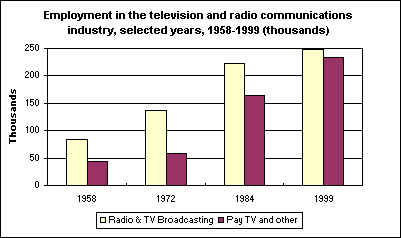October 03, 2000 (The Editor’s Desk is updated each business day.)
Pay TV employment charges along
From 1958 through 1999, employment in pay television and other communications grew by an average annual rate nearly twice that of the total nonfarm economy.

[Chart data—TXT]
Radio and television broadcasting, by contrast, grew at a pace closer to that of the economy. In 1958 radio and television broadcasting employed nearly twice as many workers as pay television and other communications; by 1999, employment levels in the two industries were about the same.
The FCC altered or abolished many of the rules regarding cable television starting in 1972. These deregulatory moves at least partly explain the hiring surge in the industry over the 1972-1984 period.
After 1984, the employment trends in both industries slowed until the early 1990s. Since 1992 employment has begun to accelerate, especially in pay television and other communications.
These data are a product of the
Current Employment Statisticsprogram. Learn more in "Job growth
in television: cable versus broadcast," by Dominic Toto, Monthly
Labor Review, August 2000.
Of interest
Spotlight on Statistics: National Hispanic Heritage Month
In this Spotlight, we take a look at the Hispanic labor force—including labor force participation, employment and unemployment, educational attainment, geographic location, country of birth, earnings, consumer expenditures, time use, workplace injuries, and employment projections.
.
Read more »
